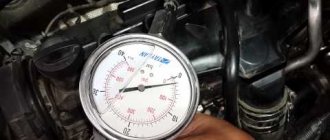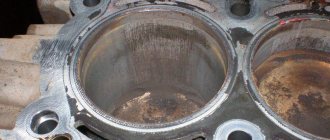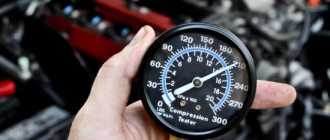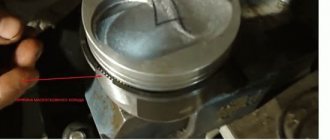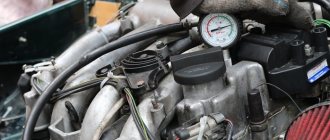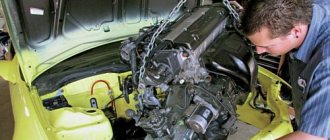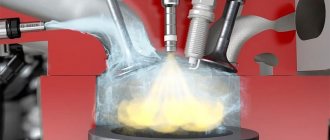17.11.2012
Engine compression
Engine compression indicates the condition of the engine, its service life, power, and torque. This procedure must be performed every 20-30 thousand kilometers, as well as before purchasing a car. Even when checking at a service center, YOU will need knowledge of “how to correctly measure compression”, because... Servicemen love to deceive and make money from you. Let's start with the theory: Compression is the pressure created in the cylinder at the end of the compression stroke. Another term is appropriate here: Engine compression ratio. The engine compression ratio is expressed in the following ratio: compression/combustion chamber volume.
What compression should be in the cylinders of a VAZ engine?
Normal engine compression is at least 10 bar (1.0 MPa), and the difference between the cylinders should not exceed 1 bar (0.1 MPa). If your compression is 11-12-11-12 from cylinders 1 to 4, then the engine is fine, but do not forget to adjust the valves every 2500 km. If you have 11-9-12-11, then you need to look for the reason and make repairs, because Driving in such conditions will only kill the engine.
How much should the ideal compression be? The ideal compression should be 14 bar for an 8-valve engine in each cylinder with minimal variation (14-14-14-14).
Correct compression (norms) for VAZ-2114
The process of measuring compression in engines
According to the regulatory and technical documentation, a limit value of compression in the cylinders of the VAZ-2114 engine has been established. Thus, an increase or decrease in the indicator is not considered normal, since excessive compression of the air-fuel mixture in the engine can lead to not very good consequences.
Also, it is worth noting that the compression in all cylinders should be relatively equal. Different indicators are not the norm and these are the first signs of a major engine overhaul.
Normal compression in the engine cylinder
As practice and many years of experience of motorists show, the compression in the cylinders should be 14 bar, but the lower limit should not fall below 11 bar .
When measuring, the difference in compression between the cylinders should not exceed 1 bar.
Example of a bad and normal compress
Let's give a clear example: 12-13-12-13 is normal compression for the engine, but 12-11-12-8 is not normal and it is believed that the engine needs diagnostics and major repairs.
Reasons for increasing compression
Compression gauge for replacing compression
It becomes clear that a decrease in compression in the engine is associated with wear of key elements, such as pistons and compression rings, main and connecting rod bearings, as well as valves. But what are the reasons for the increased compression?
So, let's look at the main ones:
- When performing repair operations related to the gas distribution mechanism, an error was made in the adjustment work , which changed the order of operation of the unit, and, accordingly, the compression in the cylinders.
- Heat on the valves , as well as the accumulation of carbon deposits on the cylinder walls and throttle assembly, leads to an increase in the compression ratio due to a decrease in space in the nodes.
- Also, the reasons for increased compression in the cylinders include engine overheating.
- The last reason for increased compression is the “occlusion” of the valve stem seals. The malfunction is diagnosed quite simply - the spark plugs are unscrewed and the oil wells are examined. An oil film indicates that there is an excess of oil and the need to replace the valve seals.
Do-it-yourself compression test
Compression measurement in the first cylinder of the engine
Compression measurement in engine cylinder 2
Compression measurement in engine cylinder 3
Compression measurement in the 4th cylinder of the engine
Compression in the cylinders must be measured using a special device - a compression meter. There are many types of them, but threaded ones are considered the best and most accurate.
- So, to measure the compression in the cylinder, you need to unscrew the spark plug and screw in the compression gauge fitting.
- Then, turn the ignition key until the engine begins to turn the crankshaft.
- The engine should start and the car enthusiast adds gas so that the engine runs a little.
- So, the compression meter measures the most accurate value.
The compression should not be lower than 11 bar, otherwise it is necessary to understand the causes of the malfunction.
How to measure engine compression?
To check the compression we need a spark plug wrench, a charged battery and a compression gauge. You also can’t do without an assistant.
- Warm up the engine to operating temperature.
- We turn out all the candles.
- We install a device for measuring compression (compressometer) into the spark plug hole that appears.
- The assistant presses the gas all the way and starts the car within 6-10 seconds.
- We remember the compression gauge readings and carry out similar operations on the remaining cylinders.
Different compression in the cylinders. What to do
Details Category: Car sales blog Created: May 11, 2019
Reasons for different compression in cylinders
The time comes when almost every driver thinks about the need for technical diagnostics of his car. And checking the compression in the cylinders is the easiest way to do this.
However, if you look at the situation from the other side, the results of such a test can be very mediocre and you should not place high hopes on this method. This example is just one of many possible diagnostic options.
The first obvious reason for low compression of a car is a very common factor - the engine pulls weakly . This is the first call to check cylinder compression.
More detailed information regarding the corresponding digital parameters of your car can be found in the attached instructions for the car.
How to measure compression
The process of assessing engine compression is very simple and short, however, we will reproduce it. You will need a fully charged battery and an engine preheated to eighty degrees. Well, and the compressor itself, without which you will not be able to obtain accurate measurement parameters.
Low and different compression in the engine, what to do?
If, after checking the compression, the compression meter shows below 10 bar in at least one cylinder, then you urgently need to find out the cause and fix the problem, otherwise you risk losing compression in the remaining cylinders.
If, for example, you do not have sufficient compression in 1.4 and any other cylinder:
- We fill a medical syringe with about 10 cubic centimeters of motor oil.
- Spray oil into the hole that appears.
- We measure the compression again.
If, after re-measuring, the compression has increased, it means the rings are worn out. If the result remains the same, it means the valves are burnt out or jammed. Stiff valves can be adjusted, and burnt valves can be replaced.
Increase compression
Yes, in some situations the compression can rise to 15 bar, which is not the norm. There is an explanation for this: all possible gaps are sealed with oil, there is no other liquid nearby. When engine oil splashes onto the piston group from below, the excess is removed from the walls by oil scraper rings. But when it comes from above, from the side of the combustion chamber, and even in large quantities, then it has nowhere to go. Part burns along with the fuel, causing white or bluish smoke to come out of the exhaust pipe, and the other part seals the cracks.
Oil enters the combustion chamber for the following reasons:
- valve oil deflectors (caps) have become unusable;
- After long-term use, the bushings inside which the valve stems move broke.
A good technician will eliminate the first reason without removing the engine head from the block by replacing the caps. The second will again require disassembly and pressing of new bushings.
High compression in the engine. Main reasons.
Don't be too happy if your compression readings are off the charts, this is in no way indicative of how cool your engine is. As stated above, the ideal compression for an 8-valve engine is 14-14-14-14. If your compression is higher than these numbers, then it’s time to think about malfunctions. High compression can damage the partitions of the pistons and tear the cylinders. Below are the main reasons for high/high compression: High compression is created due to excess oil in the cylinder, which is why it is sometimes also called “oil compression”.
- The valve stem seals (VSC) have worn out and died.
- The oil scraper rings are worn out or stuck. (In such cases, oil consumption is inevitable. Check the oil level: How to check the oil level in the engine? Also pay attention to starting the engine after a long stop, for example, in the morning. If the engine oil is consumed, the exhaust will be black).
- There may be carbon deposits in the cylinders. Try to get rid of it by decoking.
How to check engine compression correctly?
If we take into account all the factors listed above, then when measuring compression the following simple rules must be followed:
- the engine must be “warm” “warm up”;
- the fuel supply must be turned off (you can turn off the fuel pump, injectors, or use other methods to prevent fuel from entering the cylinders);
- on gasoline engines, it is necessary to remove all spark plugs (selective removal of spark plugs is unacceptable, as it increases the rotational resistance and arbitrarily reduces the speed when the engine is cranked with the starter);
- The battery must be fully charged and the starter is working properly.
Compression is measured with both the throttle valve open and closed. Moreover, each method gives its own results and allows you to identify its own defects. So, when the damper is closed, little air will enter the cylinders, the compression will be low and will be about 0.6-0.8 MPa. Air leaks in this case are comparable to its entry into the cylinder. As a result, compression becomes especially sensitive to leaks - even with small leaks, its value drops several times. This measurement allows us to draw conclusions or assumptions about the following engine defects:
- about unsatisfactory fit of the valve to the seat;
- about valve freezing, for example, due to improper assembly of the mechanism with hydraulic pushers;
- about defects in the camshaft cam profile in designs with hydraulic lifters, including uneven wear or runout of the back side of the cam
- about a lack of tightness caused by a burnout of the head gasket or a crack in the wall of the combustion chamber (these defects are accompanied by white smoke, the formation of an emulsion in the oil, and increased pressure in the cooling system)
Signs of poor compression
If you encounter the problems outlined below, then it is possible, BUT FAR FAR from a fact, that your engine has insufficient compression. Therefore, you don’t need to pay attention to the signs, but you just need to measure the compression.
- Misfires.
- Troit.
- Low dynamics.
- Engine knock.
- There is oil.
- Black smoke.
- Poor cold start.
- High fuel consumption (Causes of high fuel consumption on VAZ).
WHAT TO DO IF YOU DO NOT HAVE A COMPRESSOMETER AT HAND?
Is it possible to measure compression without a device? Practice shows that yes, it is possible. But this method will give relative and approximate readings. To measure the compression indicator without instruments, remove the spark plugs from all cylinders except the one being tested. Manually rotate the crankshaft until the compression stroke ends (watch the marks - they should match). Perform this operation on all cylinders one by one. Where the pressure is low, it will take less effort to turn the crankshaft. In this way, of course, you will not get accurate compression readings in the engine. But it is possible to understand the presence of problems.
It is recommended to measure compression every 20-30 thousand kilometers, so every car enthusiast is recommended to have his own compression gauge. Its price is not so high that it is worth saving on it.
The approximate price of a device for measuring engine compression in online stores in the capital is from 600 rubles to 2 thousand. Branded models from Western manufacturers are more expensive – up to 8 thousand. In the regions, a device for measuring compression costs no more than in the capital. Its price varies depending on the manufacturer.
The performance of the piston group depends on the compression in the engine cylinders; the VAZ-2114 standard is in the range of 13-14 bar, for example. But these dry numbers require clarification, since their meaning is not clear to all car enthusiasts. Any car owner can measure real indicators, but not everyone knows what compression should be in a working power unit under what conditions.
How to increase engine compression in other ways?
There are several options for raising compression without repair. These operations do not in any way guarantee an increase in compression, but you can try. But it is still recommended to eliminate the malfunction by mechanical action - eliminate the malfunction: replace the rings or replace the valves.
- Adjustment of valves. I tried it myself, it really works. The valve could be jammed and therefore not close, resulting in a compression leak.
- Roscoking – removes carbon deposits and excess oil in the cylinder. It only helps with stuck rings; if the valves are burnt out, there is no point in carrying out this operation.
Normal compression on a VAZ-2110
Typically, compression is checked using a special device. It is recommended to do this regularly.
Automotive compression gauge.
- About compression of the VAZ 2107 - measurement and causes of reduced pressure
Candle key.
